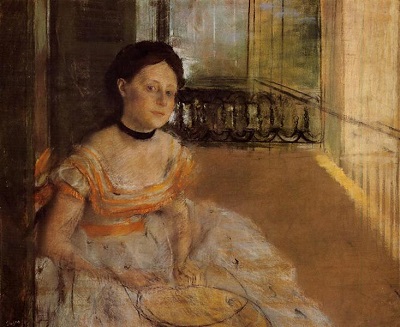
from Amazon
As an Amazon Associate, and partner with Google Adsense and Ezoic, I earn from qualifying purchases.
Edgar Degas was consumed with illustrating the social life of the upper class population in Paris.
The artist was lucky that his social status allowed for him to attend endless ballet performances, cafes, and circuses. Rather than showcasing the architecture, vast lands, or objects, the artist preferred to focus on individuals. Even though Degas was transfixed with illustrating ballerinas throughout his work, he often veered in other directions by focusing on individuals. The portrait of a woman seated on a balcony gives the viewer a glimpse to the audience watching the ballet performances. This piece has a similar element to a few other portraits by Degas, which include Elena Carafa and Madame De Rutte.
Once in a while the artist branched out to these other areas and captured the lively form of female portraits. While Degas is primarily known for his adoration of ballerinas, the artist also had a lustful edge for the nude female body. At the onset of his career, Degas created a collection of pastel pieces that illustrated the female body in all her glory bathing. Some of these pieces include After The Bath, Seated Bather, and The Toilette. While it is unknown whether Degas created his nude female portraits based on experience, they believed to be produced on his imagination. Woman Seated On A Balcony on the other hand seems to be a woman Degas was captivated by watching a ballet performance. While the woman in the piece is unknown, it seems as if Degas recreated her based on memory.
The young woman is seated in a chair near a wall. She is not seated near a balcony watching the performance, and rather is on the side. The viewer cannot spot her chair as it is covered by her grand dress. The interesting element to note from her attire is that it greatly matches those of what ballerinas wore to perform at the time. Perhaps the woman was indeed a ballerina preparing to go on stage, rather than watching the show. The woman’s top part of the dress falls gently off the shoulders exposing the upper part of her chest. Lines of a silky orange fabric cover her chest with small chiffon detailing lining the sleeves. The top part progresses into a white fabric that lines the waist, with an orange silk line of fabric that meets the top part with the skirt.
The bottom part of the dress is grand and wide in endless layers of chiffon and white lace. While the piece is based on pastel, and does not hold much detailing to it, the viewer can feel how much fabric covers the bottom half of the woman’s attire. As well, her arms begin to slowly melt into her skirt as Degas skips on detailing her. Small black lines and dots fill the skirt in a light pattern. The woman accessories her look with a thin black choker around her neck. Her short neck is met by a rounded face tilted in the direction of her body. Yet, her eyes point in the direction of the viewer starring at them through the canvas. The viewer can spot her eyes moving to stare at the on looker.
Degas adds shade and contour to her face to give a contrast. Rather than pale skin filling the piece, small glimpse of shade is evident. As there is no prominent light source in the piece, Degas still shades the left side of the woman’s body. Her hair is placed in an up-do that gently flows towards the back of her body. The viewer can spot the balcony railing near the back of the wall, at which the woman will watch the performance.